东北师范大学 语言学考试题库
- 格式:doc
- 大小:79.00 KB
- 文档页数:6
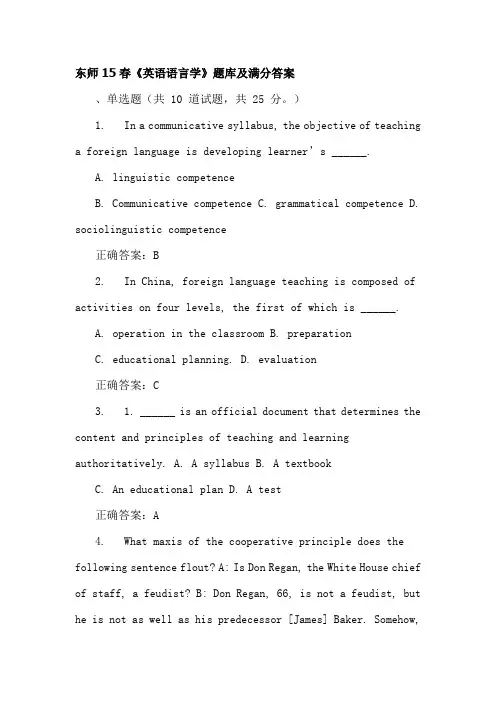
东师15春《英语语言学》题库及满分答案、单选题(共 10 道试题,共 25 分。
)1. In a communicative syllabus, the objective of teachinga foreign language is developing learner’s ______.A. linguistic competenceB. Communicative competenceC. grammatical competenceD. sociolinguistic competence正确答案:B2. In China, foreign language teaching is composed of activities on four levels, the first of which is ______.A. operation in the classroomB. preparationC. educational planning.D. evaluation正确答案:C3. 1. ______ is an official document that determines the content and principles of teaching and learning authoritatively. A. A syllabus B. A textbookC. An educational planD. A test正确答案:A4. What maxis of the cooperative principle does the following sentence flout? A: Is Don Regan, the White House chief of staff, a feudist? B: Don Regan, 66, is not a feudist, but he is not as well as his predecessor [James] Baker. Somehow,the adjective “ruthless” invariably arises when Regan discussed. A. QualityB. Quantity C. Relation D. Manner 正确答案:D5. refers to a statement in which you unnecessarily say the same thing twice using different words, for example, “He sat alone by himself”. A. TautologyB. Rhetorical deviceC. Truth conditionD. Prototype正确答案:A6. _____ is the approximate language system that the learner constructs for use in communication through the target language. A. Metalanguage B. Interlanguage C. SignD. Esperanto正确答案:B7. The term ______ is used for less drastic difference restricted to variation in pronunciation. A. sociolect B. dialectC. geographical dialectD. accent正确答案:D8. ______ is the label given to the form of a language used by any group of speakers or used in a particular field.A. varietyB. registerC. dialectD. Creole正确答案:A9. British English and American English are ______ varieties of the English language. A. functional B. social C. regional D. standard正确答案:C10. ______ is/are used most widely in a community. A. SociolectsB. regional dialectsC. The standard varietyD. Registers正确答案:C、判断题(共 30 道试题,共 75 分。
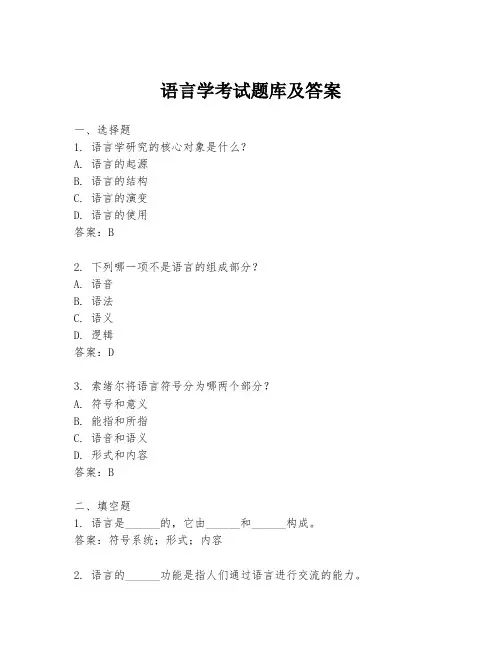
语言学考试题库及答案一、选择题1. 语言学研究的核心对象是什么?A. 语言的起源B. 语言的结构C. 语言的演变D. 语言的使用答案:B2. 下列哪一项不是语言的组成部分?A. 语音B. 语法C. 语义D. 逻辑答案:D3. 索绪尔将语言符号分为哪两个部分?A. 符号和意义B. 能指和所指C. 语音和语义D. 形式和内容答案:B二、填空题1. 语言是______的,它由______和______构成。
答案:符号系统;形式;内容2. 语言的______功能是指人们通过语言进行交流的能力。
答案:交流3. 语言的______功能是指语言能够表达思想和情感的能力。
答案:表达三、简答题1. 简述语言和言语的区别。
答案:语言是指一种抽象的符号系统,它包括语音、语法、语义等规则和结构;言语则是指个人使用语言进行交流的具体行为。
2. 描述索绪尔的“能指”和“所指”概念。
答案:索绪尔认为语言符号由“能指”和“所指”两部分组成。
“能指”指的是语言符号的声音形式,而“所指”指的是符号所代表的概念或意义。
四、论述题1. 论述语言的任意性原则及其对语言学习和教学的影响。
答案:语言的任意性原则指的是语言符号的声音形式和它所代表的概念之间没有必然的联系。
这一原则对语言学习和教学有着深远的影响,因为它意味着学习者需要记忆每个符号的声音和意义之间的联系,而不能依赖于逻辑或直观的关联。
这对语言教学提出了挑战,要求教师设计有效的教学方法来帮助学生记忆和理解这些任意的联系。
2. 分析语言的交际功能及其在现代社会中的重要性。
答案:语言的交际功能是指语言作为交流工具,使人们能够传递信息、表达情感和进行社会互动。
在现代社会,随着全球化和信息技术的发展,语言的交际功能变得尤为重要。
有效的沟通能够促进国际合作、文化交流和商业交易,同时也有助于解决社会冲突和增进理解。
因此,掌握一门或多门语言对于个人和社会的发展至关重要。
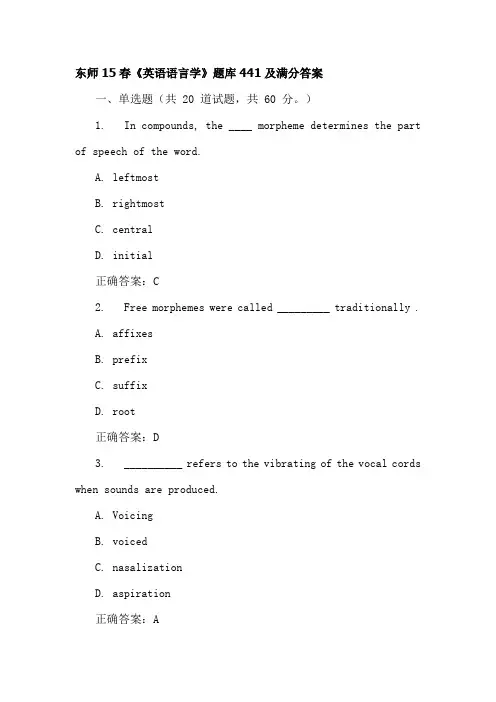
东师15春《英语语言学》题库441及满分答案一、单选题(共 20 道试题,共 60 分。
)1. In compounds, the ____ morpheme determines the part of speech of the word.A. leftmostB. rightmostC. centralD. initial正确答案:C2. Free morphemes were called _________ traditionally .A. affixesB. prefixC. suffixD. root正确答案:D3. __________ refers to the vibrating of the vocal cords when sounds are produced.A. VoicingB. voicedC. nasalizationD. aspiration正确答案:A4. A ______ is a minimal distinctive linguistic unit.A. morphemeB. wordC. phonemeD. allophones正确答案:C5. Which of the following does not belong to suprasegmental features?A. StressB. IntonationC. ToneD. Syllable正确答案:D6. _________ is a process which creates new words by putting together non-morphemic parts of existing words.A. CoinageB. BlendingC. AcronmymsD. Clipping正确答案:B7. classroom (为下列单词选择相对应的构词法)A. ConversionB. BackformationC. BlendingD. Compounding正确答案:D8. Free morphemes were traditionally called _________, and bound morphemes affixes.A. prefixesB. suffixesC. rootsD. inflectional morphemes正确答案:C9. Acronyms and abbreviations are formed by putting together the ____ letters of some or all words in a phrase or title.A. InimicalB. initiativeC. suffixingD. initial正确答案:D10. Fahrenheit (为下列单词选择相对应的构词法)A. Sound ReduplicationB. CoinageC. EponymD. Clipping正确答案:C11. The questions of “How is language acquired? How do people learn a foreign language?” are explored in __________.A. applied linguisticsB. sociolinguiticsC. psycholinguisticsD. general linguistics正确答案:C12. The features that are found over a segment or a sequence of two or more segments are called ___________.A. distinctive featuresB. non-distinctive featuresC. suprasegmental featuresD. free variation正确答案:C13. He is (watering )flowers. (为括号部分的单词选择相对应的构词法)A. ConversionB. DerivationC. BlendingD. Backformation正确答案:A14. ____ is a typical tone language.A. EnglishB. JapaneseC. ChineseD. Korean正确答案:C15. impossible (为下列单词选择相对应的构词法)A. DerivationB. ConversionC. BackformationD. Blending正确答案:A16. ______ is a process that creates new words by putting together non-morphemic parts of existing words.A. CoinageB. BlendingC. AcronmymsD. Clipping正确答案:B17. The followings are all features of language except __________.A. dualityB. productivityC. changeabilityD. displacement正确答案:C18. In the phrases a herd of cattle, a flock of sheep, both cattle and sheep contain _____ morphemes.A. oneB. twoC. threeD. four正确答案:B19. ____ is a process that creates a new word by droppinga real or supposed suffix.A. BlendingB. EponymsC. BackformationD. Clipping正确答案:C20. In more detailed transcription (sometimes referred to as narrow transcription), a sound may be transcribed with a symbol to which a smaller symbol is added in order to mark the finer distinctions. The smaller one is called ____________.A. segmentB. phonetic symbolC. markerD. diacritic正确答案:A二、判断题(共 20 道试题,共 40 分。
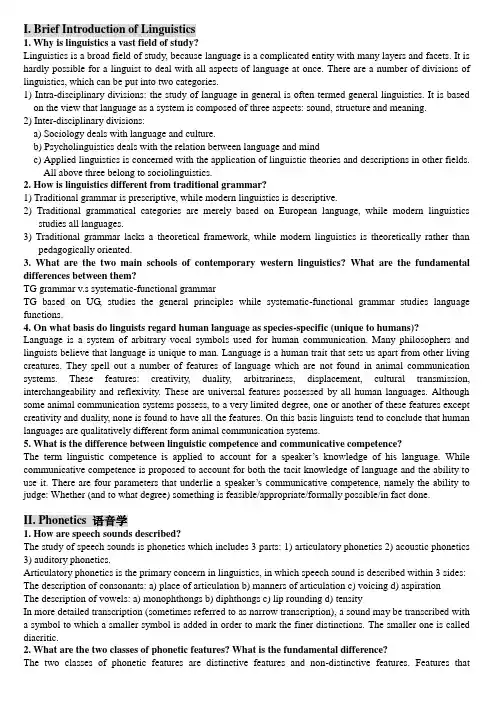
I. Brief Introduction of Linguistics1. Why is linguistics a vast field of study?Linguistics is a broad field of study, because language is a complicated entity with many layers and facets. It is hardly possible for a linguist to deal with all aspects of language at once. There are a number of divisions of linguistics, which can be put into two categories.1) Intra-disciplinary divisions: the study of language in general is often termed general linguistics. It is based on the view that language as a system is composed of three aspects: sound, structure and meaning.2) Inter-disciplinary divisions:a) Sociology deals with language and culture.b) Psycholinguistics deals with the relation between language and mindc) Applied linguistics is concerned with the application of linguistic theories and descriptions in other fields.All above three belong to sociolinguistics.2. How is linguistics different from traditional grammar?1) Traditional grammar is prescriptive, while modern linguistics is descriptive.2) Traditional grammatical categories are merely based on European language, while modern linguisticsstudies all languages.3) Traditional grammar lacks a theoretical framework, while modern linguistics is theoretically rather thanpedagogically oriented.3. What are the two main schools of contemporary western linguistics? What are the fundamental differences between them?TG grammar v.s systematic-functional grammarTG based on UG, studies the general principles while systematic-functional grammar studies language functions.4. On what basis do linguists regard human language as species-specific (unique to humans)? Language is a system of arbitrary vocal symbols used for human communication. Many philosophers and linguists believe that language is unique to man. Language is a human trait that sets us apart from other living creatures. They spell out a number of features of language which are not found in animal communication systems. These features: creativity, duality, arbitrariness, displacement, cultural transmission, interchangeability and reflexivity. These are universal features possessed by all human languages. Although some animal communication systems possess, to a very limited degree, one or another of these features except creativity and duality, none is found to have all the features. On this basis linguists tend to conclude that human languages are qualitatively different form animal communication systems.5. What is the difference between linguistic competence and communicative competence?The term linguistic competence is applied to account for a speaker’s knowledge of his language. While communicative competence is proposed to account for both the tacit knowledge of language and the ability to use it. There are four parameters that underlie a speaker’s communicative competence, namely the ability to judge: Whether (and to what degree) something is feasible/appropriate/formally possible/in fact done.II. Phonetics 语音学1. How are speech sounds described?The study of speech sounds is phonetics which includes 3 parts: 1) articulatory phonetics 2) acoustic phonetics 3) auditory phonetics.Articulatory phonetics is the primary concern in linguistics, in which speech sound is described within 3 sides: The description of consonants: a) place of articulation b) manners of articulation c) voicing d) aspirationThe description of vowels: a) monophthongs b) diphthongs c) lip rounding d) tensityIn more detailed transcription (sometimes referred to as narrow transcription), a sound may be transcribed with a symbol to which a smaller symbol is added in order to mark the finer distinctions. The smaller one is called diacritic.2. What are the two classes of phonetic features? What is the fundamental difference?The two classes of phonetic features are distinctive features and non-distinctive features. Features thatdistinguish meaning are called distinctive features, in other words, those distinguishing phonemes. Non-distinctive features do not distinguish meanings, i.e. the features belong to allophones. However, whether a phonetic feature is distinctive or non-distinctive varies from one language to another language.III. Phonology 音位学1.Analyze the two English sound segments [t] and [t h], [k] and [k h], [p] and[p h] in terms of distribution and the phonetic feature that distinguishes them.[t] and [t h], [k] and [k h], [p] and [p h] are the allophones of the same phoneme /t/, /k/, /p/. They are in complementary distribution and share phonetic features.[t] is an unaspirated voiceless alveolar stop; [t h] is an aspirated voiceless alveolar stop[k] is an unaspirated voiceless velar stop; [k h] is an aspirated voiceless velar stop[p] is an unaspirated voiceless bilabial stop;[p h] is an aspirated voiceless bilabial stop/t/→ [t] / [voiceless, fricative, alveolar]_______[t h]/ elsewhere[k] and [k h], [p] and [p h] is the same as above.2.Analyze the change of feature concerning the vowels in "bean, time, farm" and generalize the rule. This rule is called nasalization, that is a vowel becomes nasalized before a nasal segment, possible followed by one or two consonants within a syllable.V →[+nasal] / ____ [+nasal]3.Analyze the relation of {im-}, {in-}, {ir-}, {il-} in English and generalize of their distribution.{im-}, {in-}, {ir-}, {il-} are the allomorphs of the same morpheme {in-},which represents the negative meaning as a prefix.{in-}→ {im-} / ________ [m,p, b] [bilabial stop, or nasal]{ir-} / _________ [r] [retroflex, alveolar]{il-} / _________ [l] [lateral, alveolar]{in-} / elsewhere4. How do you account for the relation between phonetics and phonology?1) Phonology and phonetics are both concerned with the study of speech sounds, but the two differ in perspectives.2) Phonetics, particularly articulatory phonetics, focuses on how speech sounds are produced, what phonetic features they have, and how to transcribe them. In phonetics, sound segments are assumed to be invariable; variations are overlooked.3) Phonology focuses on three fundamental questions. What sounds make up the list of sounds that can distinguish meaning in a particular language? What sounds vary in what ways in what context? What sounds can appear together in a sequence in a particular language?5. What are the functions of supra-segmental features?Supra-segmental features are distinctive features that can be found in units of syllables, words, phrases and sentences. They are stress, intonation and tone. Intonation and stress generally occur simultaneously in utterance. The simultaneous functioning of the features serves to highlight the information focus, or to eliminate ambiguity of the phrases and sentences. "a greenhouse" and "a green house", "Jack hit the ball under the desk".Tone is the variation of pitch to distinguish words. English is not a tone language, but Chinese is a typical tone language in which each of the four tones means four different words.6. Analyze the change of feature concerning the liquids and nasals in flight, snow, smart, pray and generalize the rule.Liquids /l/ /r/ appear after a voiceless consonant /f/ and /p/ respectively, they are devoiced.Nasals /n//m/ appear after a voiceless consonant /s/, they are devoiced.Rule: Devoice a voiced consonant after a voiceless consonant.Or:When the English liquids, glides and the two anterior nasals appear after a voiceless consonant, it is devoiced. This rule can be expressed as follows: devoice a voiced consonant after a voiceless consonant,that is, [+voiced+consonantal] [-voiced] / [-voiced+consonantal]-. The phonology /l/ /r/ belongs to liquids, and /m//n/ belong to anterior nasals. All these four are voiced consonant, but in these words, they change to the voiceless, for they appear after voiceless consonants.7. What is distinctive feature?Features that distinguish meaning are called distinctive features, in other words, just those distinguishing phonemes, such as [b] and [p] in the words between "big" and "pig".8. Analyze the relation of -er, -est and more, most in Englsih and generalize their distribution.They are in complementary distribution. -er and more, -est and most are allomorphs. More and most are put before adjectives and adverbs composed of two or more syllables.IV. Morphology 形态学1. What are the categories of lexical meaning?Lexical meaning includes:a) Referential meaning (also denotative meaning) is the central meaning and it is more stable and universal.b) Associative meanings. Associative meanings are meanings are meanings that hinge on referential meaning, which are less stable and more culture-specific.Types of associative meanings: connotative meaning, social meaning, affective meaning, reflected meaning,collective meaning2. How are words decomposed into their constituents?1) Words are composed of one or more than one morphemes.2) Morphemes are the smallest meaningful unit of language.3) A morpheme may be represented by different forms, called allomorphs.4) Morphemes can be categorized into 2 kinds. a) Free morphemes (they constitute words by themselves)b) bound morphemes (they are never used independently)5) Bound morphemes include inflectional morphemes and derivational morphemes.6) The distinction between a free morpheme and a bound morpheme is whether it can be used independently in speech or writing.V. Syntax 句法1.What are the aspects of syntactic knowledge?Knowing which strings of words are grammatical and which are not is part of syntactic knowledge. In addition, native speakers know at least the following:1) structural ambiguity---which strings of words have more than one meaning.2) word order---different arrangements of the same words have different meanings.3) grammatical relations---what element relates to what other element directly or indirectly4) recursion---the repeated use of the same rules to create infinite sentences5) sentence relatedness---sentences may be structurally variant but semantically related6) syntactic categories---a class of words or phrases that can substitute for one another without loss of grammaticality.2. How does transformational grammar (转换生成语法)account for sentence- relatedness?1) Sentence- relatedness: sentences may be structurally variant but semantically related.2) According to Chomsky, a grammar as the tacit shared knowledge of all speakers is a system of finite rules by which an infinite number of sentences can be generated. He attempts to account for this aspect of syntax by postulating that deep structures and surface structures.3) Deep structures are the basic structures generated by phrase structure rules.4) Surface structures are derived structures, the structures of sentences that we actually speak. Surface structures are derived from deep structures through transformational rules which include replacement, insertion, deletion and coping, etc.5) There are five transformations: particle movement transformation, replacement, insertion, deletion and copying.3. What is the advantage of immediate constituent analysis compared with traditional grammar?1) The concept of immediate constituent is an important concept of structural grammar, which is characterized by a top-down analysis. A sentence is seen as a constituent structure, i.e. all the components of the sentence are constituent. A sentence can be cut into sections. Each section is its immediate constituent. Then each section can be further cut into constituents. This on-going cutting is termed immediate constituent analysis.2) Traditional grammar mainly analyzes a sentence horizontally with a synthetic (bottom-up) approach. It focuses on the product of a sentence rather than the procedure. It is prescriptive in nature.3) Therefore, immediate constituent analysis adds a new dimension to the analysis of sentence structure. In this way, sentence structure is analyzed not only horizontally but also vertically. In other words, this way of syntactic analysis can account for the linearity and the hierarchy of sentence structure, and, therefore, structural ambiguity.4.What part of syntax can phrase structure rules account for and what they cannot?1) Phrase structure rules are rules that specify the constituents of syntactic categories.2) Deep structures are the basic structures generated by phrase structure rules, but the surface structures are derived from the deep structures, and is generated by transformational rules.3) All in all, phrase structure rules can account for structural ambiguity, word order, grammatical relations, recursion, and syntactic categories; but they cannot account for sentence relatedness.5. Analyze the sentence in terms of type of process, mood structure, and theme and rheme:The academician will address the issue of the legitimacy of cloning at the conference.1) It is the verbal process. In this sentence, the sayer is the academician, the receivers are the people at the conference though it is not mentioned but we can infer it from the sentence. The verbiage is the issue of the legitimacy of cloning.2) This sentence is the realization of linguistic interaction; it is the giving of information. Its syntactic form is statement. The subject is the academician; the finite is the verbal operator “will”.3) The constituent that stands for the starting-point for the message is termed theme; all the rest of the sentence is labeled rheme. In this sentence, the theme is the academician and “the issue of the legitimacy of cloning at the conference” is the rheme.VI. Semantics语义学1. What are the components of metaphor?Target domain and source domain are the components of metaphors. That is to say all metaphors are composed of two components. This allows us to understand one domain of experience in terms of another. The domain to be conceptualized is called target domain, while the conceptualizing domain is termed the source domain. The transference of properties of the source domain to the target domain is referred to by some cognitive linguistics as mapping. The source domain is concrete and familiar. The target domain is abstract and novel.2. Why is metaphor essential in cognition?Our linguistic knowledge is part of general cognition and linguistic categorization is a product of the human mind. According to this view, meaning is based on conventionalized conceptual structures. Semantic structure reflcects the mental categories which are formed on the basis of experiences. Metaphor is an essential element in our categorization of the world and our thinking process. Cognitive linguistics has shown that metaphor is not an unusual or deviant way of using language. The use of metaphor is not confined to literature, rhetoric and art. It is actually ubiquitous in everyday communication. Metaphors as linguistic expressions are possible precisely because there are metaphors in a person's conceptual systems.3. How is word meaning analyzed? And what are the limitations of the method of analysis?1) In modern linguistics, semanticists manifest that the sense of a word can be analyzed in terms of a set of more general sense components (or semantic properties/features). The approach that analyzes word meaning by decomposing it into its atomic features is called componential analysis (CA).2) The limitations of componential analysis are apparent. It cannot be applied to the analysis of all lexicons, merely to words within the same semantic field. It is controversial whether semantic features are universal prime of word meanings in all languages.3) Advantages: a. It is a breakthrough in the formal representation of meaning. Once formally represented,meaning components can be seen. b. It reveals the impreciseness of the terminology in the traditional approach to meaning analysis. CA examines the components of sense. The more semantic features a word has, the narrower its reference is.4. Analyze the semantic properties of the given cooking terms, using the features [+/- WATER], [+/-FAT], [+/- PAN], [+/- POT], [+/- OVEN], [+/- SIEVE], etc.boil: [+WATER] [-FAT] [- PAN] [+ POT] [- OVEN] [- SIEVE]fry: [- WATER] [+FAT] [+ PAN] [- POT], [- OVEN] [+SIEVE]steam: [+WATER] [-FAT] [- PAN] [+POT] [-OVEN] [- SIEVE]stew: [+WATER] [+FAT] [- PAN] [+ POT] [- OVEN] [- SIEVE]bake: [- WATER] [+FAT] [- PAN] [- POT] [+ OVEN] [- SIEVE]5. Analyze the semantic differences of father and daddy in the given sentences, using Leech's classification of lexical meanings.It is easy for every man to be a father, but not to be a daddy.They differ in affective meaning. Affective meaning is what is communicated of the feeling or attitude of the speaker or writer toward what is referred to. "Father" is commending in sense while "daddy" is rich in passion.6. Analyze the difference between summon and call in terms of register.Register refers to varieties according to use. Summon is a formal word, used in court of law to order sb to appear, while call is widely used in daily life.7. Point out the semantic problem of the sentence “The orphan is staying with his parents.”There are some sentences which sound grammatical but meaningless. The sentence "the orphan is staying with his parents” is just one example. This sentence is always false which is called contradiction. An orphan is a child whose parents are dead, or a child who has been deprived of parental care. The theme (the orphan) and the rheme (is staying with his parents) are incompatible.VII. Pragmatics 语用学1.Write 3 sentences, each of which contains it in either euphoric reference or endothermic reference(anaphoric or cataphoric)1) It is rather foggy these days."It" here refers to the weather. It is an euphoric reference, referring to the word outside linguistic forms.2) It is so far hard to tell how many lives are claimed in the catastrophe."It" refers to the following expression "how many lives are claimed in the catastrophe", which is a linguistic form. Thus, it is an endothermic reference, specifically, cataphoric reference.3) The most powerful earthquakes triggered massive tidal waves that slammed into coastlines across Asia yesterday. It killed over 30,000 people in Sri Lanka, Indonesia, India, Thailand, Malaysia, Myanmar, Bangladeshand Maldives."It" refers to the preceding expression that "massive tidal waves slammed into coastlines across Asia yesterday". Therefore, it is an endothermic reference, specifically, anaphoric reference..2. Point out the maxim flouted and the implicature of B `s utterance:A: Did you notice something odd between the host and hostess?B: Have another glass of beer?The maxim of relation is violated. The implicature of B’s utterance: the hearer doesn’t want to gossip about those people.3. Point out the degree of formality of:It is gratifying that cooperative program has been proceeding smoothly. Degree of formal4. Analyze the ambiguity of the two sentences, telling the difference:1) Flying planes can be dangerous.2) She cannot bear children.1) a. The behavior of flying planes can be dangerous.b. Planes which are flying can be dangerous.2) a. She cannot tolerate children.b. She cannot give birth to a baby..c. she can not carry a child.★How do you account for the relation between semantics and pragmatics.They are two separate fields. Both study meaning, but semantics studies the conventional meaning of a word while pragmatics studies the international meaning, the meaning in use. Semantics is bilateral while pragmatics is trilateral. Semantics studies the relationship between sign and meaning, but pragmatics studies the sign, meaning and user.VIII. Sociolinguistics 社会语言学1. How do sociolinguists classify the varieties of English?1) The term variety is the label given to the form of a language used by any group of speakers or used in a particular field. A variety is characterized by the basic lexicon, phonology, syntax shared by members of the group. Varieties of a language are of four types: the standard variety, regional dialects, sociolects and registers.2) The standard variety is the form of a language used by the government and communication media, taught in schools and universities and is the main or only written form.3) A regional dialect is a variety of a language spoken by people living in an area. For example, the English language has many regional dialects. British English, American English, Australian English. Indian English, South African English, etc. are all regional varieties of the language. One dialect is distinctive from another phonologically, lexically and grammatically.2. Analyze the cause of the error that some Chinese speakers of English use although and but within one sentence.In the process of analyzing learners' language, error analysis is a milestone. Explaining errors is the final but very important step in error analysis. In terms of sources, errors are divided into interlingual errors and intralingual errors. Interlingual errors are caused by mother tongue interference which means the negative role one's knowledge of L1 to L2 learning. In Chinese, we can use “不但”,“而且”in the same sentence, so some Chinese speakers transfer this expression directly to English. But according t o English grammar, “although” and “but” can not appear in the same sentence. This phenomenon is a kind of negative transfer of learners' syntactic knowledge. This is a typical phenomenon of interference in learning.。
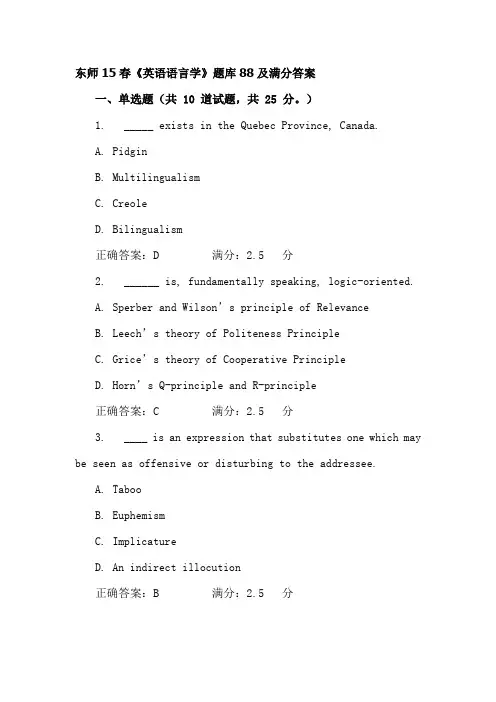
东师15春《英语语言学》题库88及满分答案一、单选题(共 10 道试题,共 25 分。
)1. _____ exists in the Quebec Province, Canada.A. PidginB. MultilingualismC. CreoleD. Bilingualism正确答案:D 满分:2.5 分2. ______ is, fundamentally speaking, logic-oriented.A. Sperber and Wilson’s principle of RelevanceB. Leech’s theory of Politeness PrincipleC. Grice’s theory of Cooperative PrincipleD. Horn’s Q-principle and R-principle正确答案:C 满分:2.5 分3. ____ is an expression that substitutes one which may be seen as offensive or disturbing to the addressee.A. TabooB. EuphemismC. ImplicatureD. An indirect illocution正确答案:B 满分:2.5 分4. The pioneering investigation done by William Labov in New York City in 1966 was to test ______ among different groups of speakers.A. sociolectsB. registersC. regional dialectsD. accents正确答案:A 满分:2.5 分5. 1. ______ is an official document that determines the content and principles of teaching and learning authoritatively.A. A syllabusB. A textbookC. An educational planD. A test正确答案:A 满分:2.5 分6. ______ refers to the fact that a speaker changes from one language to the other when talking about different topics or in different situations.A. BilingualismB. Code-mixingC. Code-switchingD. Pidgin正确答案:C 满分:2.5 分7. Sodium Chloride and salt, which denote the same substance, differ in ______ of communication.A. FieldB. RegisterC. ModeD. Tenor正确答案:A 满分:2.5 分8. ______ is the basic teaching unit in the structural syllabus.A. the wordB. the discourseC. the sentenceD. the text正确答案:C 满分:2.5 分9. Children all undergo ________ stages of language development.A. babbling, two-word, holophrastic and the telegraphic speechB. babbling, two-word, telegraphic speech and the holophrasticC. babbling, holophrastic, two-word, and the telegraphic speechD. babbling, holophrastic, telegraphic speech and the two-word正确答案:C 满分:2.5 分10. is used to refer to a specific-general semantic relationship between lexical items. Dog and cat are subordinates of livestock.A. MeronymyB. HyponymyC. PolysemyD. Antonymy正确答案:B 满分:2.5 分二、判断题(共 30 道试题,共 75 分。
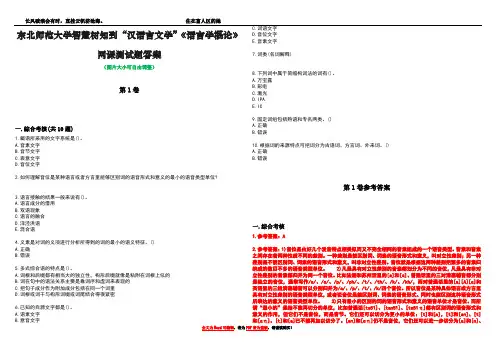
东北师范大学智慧树知到“汉语言文学”《语言学概论》网课测试题答案(图片大小可自由调整)第1卷一.综合考核(共10题)1.藏语所采用的文字系统是()。
A.音素文字B.音节文字C.表意文字D.音位文字2.如何理解音位是某种语言或者方言里能够区别词的语音形式和意义的最小的语音类型单位?3.语言接触的结果一般来说有()。
A.语言成分的借用B.双语现象C.语言的融合D.洋泾浜语E.混合语4.义素是对词的义项进行分析所得到的词的最小的语义特征。
()A.正确B.错误5.多式综合语的特点是()。
A.词根和后缀都有相当大的独立性,构形后缀就像是粘附在词根上似的B.词在句中的语法关系主要是靠词序和虚词来表现的C.把句子成分作为附加成分包括在同一个词里D.词根或词干与构形词缀或词尾结合得很紧密6.已知的自源文字都是()。
A.语素文字B.意音文字C.词语文字D.音位文字E.音素文字7.词类(名词解释)8.下列词中属于简缩构词法的词有()。
A.万宝露B.彩电C.激光D.IPAE.IC9.固定词组包括熟语和专名两类。
()A.正确B.错误10.根据词的来源特点可把词分为古语词、方言词、外来词。
()A.正确B.错误第1卷参考答案一.综合考核1.参考答案:A2.参考答案:1)音位是由好几个发音特点相类似而又不完全相同的音素组成的一个语音类型。
音素和音素之间存在着两种性质不同的差别。
一种差别是能区别词、词素的语音形式和意义,叫对立性差别;另一种差别是不能区别词、词素的语音形式和意义,叫非对立性差别。
音位就是根据这两种差别把繁多的音素归纳成的数目不多的语音类型单位。
2)凡是具有对立性差别的音素都划分为不同的音位,凡是具有非对立性差别的音素都归并为同一个音位。
比如法语和苏州话里的[a]和[ɑ]、普通话里的三对清塞辅音都分别是独立的音位,通常写作/a/、/ɑ/、/p/、/ph/、/t/、/th/、/k/、/kh/,而对普通话里的[a][A][ɑ]和英语里的三组清塞辅音可以分别归并为/a/、/p/、/t/、/k/四个音位。
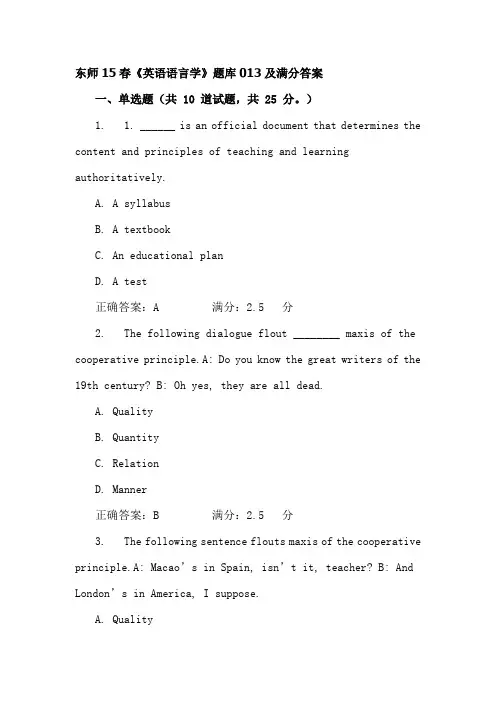
东师15春《英语语言学》题库013及满分答案一、单选题(共 10 道试题,共 25 分。
)1. 1. ______ is an official document that determines the content and principles of teaching and learning authoritatively.A. A syllabusB. A textbookC. An educational planD. A test正确答案:A 满分:2.5 分2. The following dialogue flout ________ maxis of the cooperative principle.A: Do you know the great writers of the 19th century? B: Oh yes, they are all dead.A. QualityB. QuantityC. RelationD. Manner正确答案:B 满分:2.5 分3. The following sentence flouts maxis of the cooperative principle.A: Macao’s in Spain, isn’t it, teacher? B: And London’s in America, I suppose.A. QualityB. QuantityC. RelationD. Manner正确答案:A 满分:2.5 分4. refers to a specific-general semantic relationship between lexical items. Dog and cat are subordinates of livestock.A. MeronymyB. HyponymyC. PolysemyD. Antonymy正确答案:B 满分:2.5 分5. The term ______ is the label given to the form of a language used by any group of speakers or used in a particular field.A. varietyB. registerC. dialectD. Creole正确答案:A 满分:2.5 分6. ______ is, fundamentally speaking, logic-oriented.A. Sperber and Wilson’s principle of RelevanceB. Leech’s theory of Politeness PrincipleC. Grice’s theory of Cooperative PrincipleD. Horn’s Q-principle and R-principle正确答案:C 满分:2.5 分7. What kind of pre-sequence is A’s first utterance in the following discourse? A: Do you know what I want to tell you about Mr. Smith? B: What? A: I saw him flirting with a lady at a party. B: Does his wife know that? A: Of course, she does. The lady is his wife.A. Pre-invitationB. Pre-requestC. Pre-announcementD. Pre-apology正确答案:C 满分:2.5 分8. 1. The term ______ is the label given to the form ofa language used by any group of speakers or used in a particular field.A. varietyB. registerC. dialectD. Creole正确答案:A 满分:2.5 分9. _________ is a term widely used in sociolinguistics to refer to “varieties according to use.”A. fieldB. modeC. tenorD. register正确答案:D 满分:2.5 分10. The idea that people cooperate with each other in conversing is generalized by Grice (1975) as __________.A. the principle of relevanceB. cooperative principleC. the politeness principleD. the theory of prototypes正确答案:B 满分:2.5 分二、判断题(共 30 道试题,共 75 分。
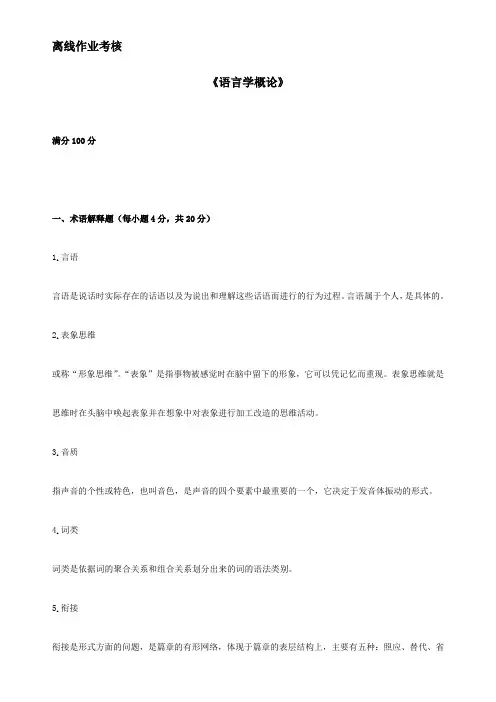
离线作业考核
《语言学概论》
满分100分
一、术语解释题(每小题4分,共20分)
1.言语
言语是说话时实际存在的话语以及为说出和理解这些话语而进行的行为过程。
言语属于个人,是具体的。
2.表象思维
或称“形象思维”。
“表象”是指事物被感觉时在脑中留下的形象,它可以凭记忆而重现。
表象思维就是思维时在头脑中唤起表象并在想象中对表象进行加工改造的思维活动。
3.音质
指声音的个性或特色,也叫音色,是声音的四个要素中最重要的一个,它决定于发音体振动的形式。
4.词类
词类是依据词的聚合关系和组合关系划分出来的词的语法类别。
5.衔接
衔接是形式方面的问题,是篇章的有形网络,体现于篇章的表层结构上,主要有五种:照应、替代、省。
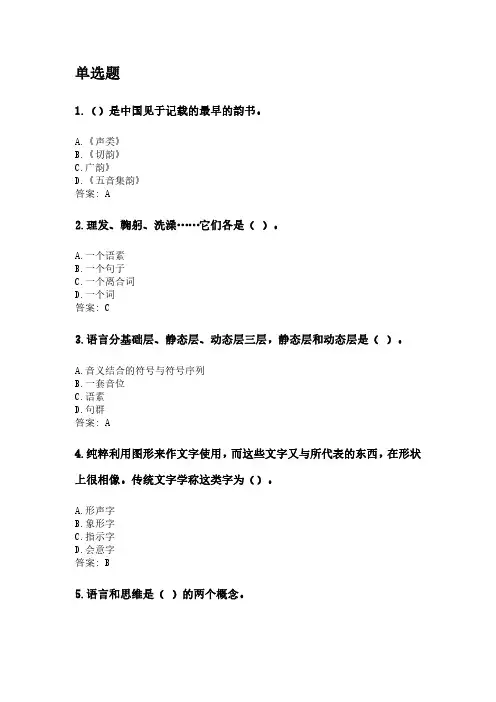
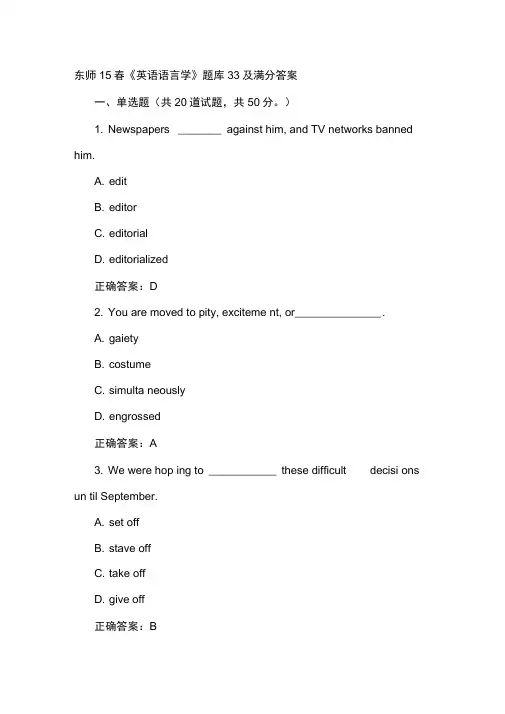
东师15春《英语语言学》题库33及满分答案一、单选题(共20道试题,共50分。
)1. Newspapers _______ against him, and TV networks banned him.A. editB. editorC. editorialD. editorialized正确答案:D2. You are moved to pity, exciteme nt, or______________ .A. gaietyB. costumeC. simulta neouslyD. engrossed正确答案:A3. We were hop ing to ___________ these difficult decisi ons un til September.A. set offB. stave offC. take offD. give off正确答案:B4. I worked so late in the office last night that I hardlyhad time ___ the last bus.A. to have caughtB. to catchC. catch ingD. hav ing caught正确答案:B5. I could see at once that the lock had bee n _________with.A. tamperedB. satiatedC. backedD. un frosted正确答案:A6. Televisi on sells us in sta nt ______ .A. gratifyB. gratitudeC. gratificati onD. grate正确答案:C7. ____________________________ I n fact it was this sile nee thatall the last mome nts of our climb.A. domin at ingB. domin atedC. domin atesD. domin ate正确答案:B8. Si nee every one we knew could sew _______ , praise was rarely han ded out for the com monly practiced craft.A. compete ntlyB. compete ntC. stitchD. apron like正确答案:A9. They ________ to follow him, eager to be touched by afew baptismal drops.A. tuneB. reactC. rebelD. surge正确答案:D10. We may fail to see how a __________ Deity could wishus to draw such conclusions from the hierarchical order He has created.A. objectiveB. ben evole ntC. sen time ntD. scruple正确答案:B11. It only took me an hour to pick up the _________ of skii ng.A. populaceB. stalki ngC. omni pote neeD. rudime nts正确答案:D12. This gifted woman's daughter (my wife) was taught her mother ' s __________ s kills.A. materialB. allegedC. gruesomeD. ven erable正确答案:D13. The soldiers had _________ barricades to protect themselves.A. erectedB. amplifiedC. con formedD. orda ined正确答案:A14. Medicare has ________ the populati on into reassuri ng itself that the once terrible financial burdens of late-lifeill nesses are now eradicated.A. morbidB. eapedC. toiledD. lulled正确答案:D15. After the rece nt sca ndal, the priest is expected todo the _______ thi ng and resig n from his positi on.A. decentB. celebratedC. wiltedD. bla nd正确答案:A16. It takes the huma n voice to ________ t hem with the shades of deeper meaning.A. refuseB. con fuseC. i nfuseD. refus ing正确答案:C17. A man was not stamped as a ____________ for protesting aga inst vivisecti on.A. ir onB. triumphC. crankD. imbecile正确答案:C18. When a local paper has a monopoly in a region, as most of them do, why is it n ecessary to aim at the lowest com mon_______ ?A. serviceB. featureC. denomin atorD. dispatch正确答案:C19. I ‘ m usually ____________ by beggars and drunks as I walk to the stati on.A. batteredB. raggedC. accostedD. terraced正确答案:C20. The vocabulary and grammatical differe nces betwee n British and American English are so trivial and few ashardly _ .A. no ticedB. to be no ticedC. being no ticedD. to no tice正确答案:B二、判断题(共20道试题,共50分。
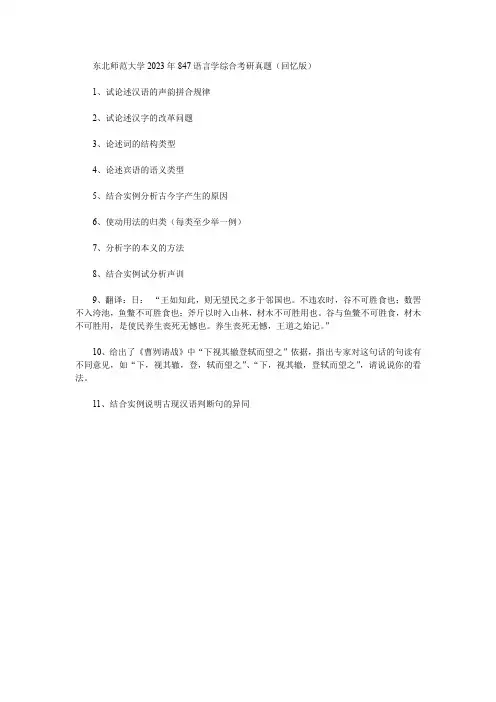
东北师范大学2023年847语言学综合考研真题(回忆版)
1、试论述汉语的声韵拼合规律
2、试论述汉字的改革问题
3、论述词的结构类型
4、论述宾语的语义类型
5、结合实例分析古今字产生的原因
6、使动用法的归类(每类至少举一例)
7、分析字的本义的方法
8、结合实例试分析声训
9、翻译:日:“王如知此,则无望民之多于邻国也。
不违农时,谷不可胜食也;数罟不入洿池,鱼鳖不可胜食也;斧斤以时入山林,材木不可胜用也。
谷与鱼鳖不可胜食,材木不可胜用,是使民养生丧死无憾也。
养生丧死无憾,王道之始记。
”
10、给出了《曹刿请战》中“下视其辙登轼而望之”依据,指出专家对这句话的句读有不同意见,如“下,视其辙,登,轼而望之”、“下,视其辙,登轼而望之”,请说说你的看法。
11、结合实例说明古现汉语判断句的异同。
东师15春《英语语言学》题库1及满分答案单选题(共 10 道试题,共 25 分。
)1. The motivation that the learners have a sense of achievement as long as they learn if of vital importance may be termed ____ motivation. A. instrumental B. integrative C. cognitive D. none of them正确答案:C2. _________ is a term widely used in sociolinguistics to refer to “varieties according to use.” A. field B. mode C. tenor D. register正确答案:D3. Words and phrases like now, yesterday, next week, in three day, etc. are called __________. A. person deixis B. time deixis C. place deixis D. discourse deixis正确答案:B4. Except _________, the followings are acknowledged as important factors in second language acquisition. A. motivation B. nationality C. ageD. learning strategy正确答案:B5. Children all undergo ________ stages of language development. A. babbling, two-word, holophrastic and the telegraphic speech B. babbling, two-word, telegraphic speechand the holophrastic C. babbling, holophrastic, two-word, and the telegraphic speech D. babbling, holophrastic, telegraphic speech and the two-word 正确答案:C6. The idea that people cooperate with each other in conversing is generalized by Grice (1975) as __________.A. the principle of relevanceB. cooperative principleC. the politeness principleD. the theory of prototypes 正确答案:B7. _____ is used between family members and very close friends. A. The consultative style B. The casual style C. The intimate style D. The formal style正确答案:C8. In a communicative syllabus, the objective of teachinga foreign language is developing learner’s ______.A. linguistic competenceB. Communicative competenceC. grammatical competenceD. sociolinguistic competence正确答案:B9. Sodium Chloride and salt, which denote the same substance, differ in ______ of communication. A. Field B. Register C. Mode D. Tenor正确答案:A10. The study of meaning is defined as___________. A. linguistics B. semantics C. morphology D. pragmatics 正确答案:B、判断题(共 30 道试题,共 75 分。
北师语言学考研真题及答案一、选择题1. 下列哪项不是语言学研究的范畴?A. 语音学B. 语法学C. 词汇学D. 心理学答案:D2. 语言学中的“音素”是指:A. 语音的最小单位B. 语言中最小的意义单位C. 语言中最小的语法单位D. 语言中最小的书写单位答案:A3. 以下哪个选项是“同音异义词”的例子?A. 书(书籍)和书(书写)B. 书(书籍)和树(植物)C. 书(书籍)和输(输掉)D. 书(书籍)和梳(梳子)答案:C二、填空题4. 语言学的四大分支包括语音学、语法学、______和______。
答案:词汇学;语用学5. 语义学研究的是语言的______,而语用学研究的是语言的______。
答案:意义;使用三、简答题6. 简述语言的任意性原则。
答案:语言的任意性原则是指语言符号和它所代表的意义之间没有必然的、自然的联系,而是一种社会约定俗成的关系。
这一原则由索绪尔提出,强调了语言符号的任意性,即同一概念在不同语言中可能用完全不同的符号来表达。
7. 解释什么是“双重否定”以及它在不同语言中的表现。
答案:双重否定是指在句子中使用两个否定词来表达肯定意义的现象。
在某些语言中,如英语,双重否定会导致意义上的混淆,而在其他语言,如西班牙语或俄语中,双重否定则被接受并用来加强否定的语气。
四、论述题8. 论述现代语言学与传统语言学的主要区别。
答案:现代语言学与传统语言学的主要区别在于研究方法和理论框架。
传统语言学更侧重于语言的规范性和历史性,而现代语言学则采用更为科学的方法,关注语言的多样性、变化和发展。
现代语言学强调语言的功能性和使用性,使用结构主义、生成语法、认知语言学等多种理论来分析语言现象。
以上内容为模拟的北师语言学考研真题及答案,实际考试题目和答案可能会有所不同。
考生在准备考研时应以官方发布的考试大纲和真题为准,进行系统的复习和准备。
东北师范大学22春“英语”《英语语言学》作业考核题库高频考点版(参考答案)一.综合考核(共50题)1.A natural language is a mixed language which has become the mother tongue of a speech community.()A、正确B、错误参考答案:B2.Immediate constituent analysis adds a new dimension to the analysis of sentence structure.()A.错误B.正确参考答案:B3.The vibrating of the vocal cords when sounds produced is regarded as ____.A.VoicingB.voicedC.nasalizationD.aspiration参考答案:A4.Consonants can be described in terms of places of articulation, manners of articulation, and vibrating.()A.错误B.正确参考答案:AEnglish is not an example of SVO languages.()A.错误B.正确参考答案:B6.Arbitrariness is the first and foremost striking feature of human language.()A、正确B、错误参考答案:B7.The ____________ function (sometimes also referred to as experiential function) is realized by the transitivity system of language.A、ideationalB、interpersonalC、textualD、logical参考答案:A8.____ is the first and foremost striking feature of human language.A、creativityB、arbitrarinessC、displacementD、interchangeability参考答案:A9.Arbitrariness is the first and foremost striking feature of human language.()A.错误B.正确10.Syntactically, Japanese is an isolating language.()A、正确B、错误参考答案:B11.A textbook is an official document that authoritatively determines the content and principles of teaching and learning.()A.错误B.正确参考答案:A12.A number of pisions of linguistics can be put into two categories: intra-disciplinary pisions and inter-disciplinary pisions.()A.错误B.正确参考答案:B13.Semantics is the only discipline that studies meaning.()A、正确B、错误参考答案:B14.The term Creole is the label given to the form. of a language used by any group of speakers or used in a particular field.()A.错误参考答案:A15.The process that puts an existing word of one class into another class is ______.A、ConversionB、AbbreviationC、EponymsD、Blending参考答案:A16.The general roles language play are termed meta. grammar.()A.错误B.正确参考答案:A17.Some young people have (brunch) quite often. (为括号部分的单词选择相对应的构词法)A.DerivationB.BlendingC.BackformationD.Acronym参考答案:B18.The pioneering investigation done by William Labov in New York City in 1966 was to test accents among different groups of speakers.()A、正确B、错误参考答案:Bintentional meanings.()A、正确B、错误参考答案:A20.Krashen’s Monitor Theory belongs to nativist theories.()A、正确B、错误参考答案:A21.Age is an important factor in second language acquisition.()A.错误B.正确参考答案:B22.refers to the process by which people use language to classify the world around and inside them.A.ApproachB.CategorizationC.PrototypeD.Cognition参考答案:B23.______ is the basic teaching unit in the structural syllabus.A、the wordB、the discourseC、the sentenceD、the text24.The voiceless bilabial stop in pin and the one in spin are in complementary distribution.()A、正确B、错误参考答案:A25.In more detailed transcription (sometimes referred to as narrow transcription), a sound may be transcribed with a symbol to which a smaller symbol is added in order to mark the finer distinctions. The smaller one is called ____________.A、segmentB、phonetic symbolC、markerD、diacritic参考答案:A26.impossible (为下列单词选择相对应的构词法)A.DerivationB.ConversionC.BackformationD.Blending参考答案:A27.[u:] possesses the features [+high][+back][+round][-tense].()A、正确B、错误参考答案:B28.B、CoinageC、EponymD、Clipping参考答案:C29.Pragmatics is defined as the study of meaning.()A.错误B.正确参考答案:A30.Language has the following features except ____.A.dualityB.productivityC.changeabilityD.displacement参考答案:C31.Language can be used to refer to things real or imagined, past, present or future because it has the feature of interchangeability.()A、正确B、错误参考答案:B32.The syllabus and the textbooks are prepared according to the social aim for teaching a language.()A、正确B、错误参考答案:A33.Code-switching refers to the fact that a speaker changes from one language to the other in different situations or when talking about different topics.()A、正确B、错误参考答案:A34.A phoneme is a minimal distinctive linguistic unit.()A、正确B、错误参考答案:A35.Orlon (为下列单词选择相对应的构词法)A.Sound ReduplicationB.CoinageC.EponymD.Clipping参考答案:B36.A ___________ is a mixed language which has become the mother tongue of a speech community.A、pidginB、creoleC、EsperantoD、natural language参考答案:B37.Creativity is one of the features of language.()A、正确参考答案:A38.A green bottle is a kind of fly.()A、正确B、错误参考答案:A39.The following are all suprasegmental features except ____.A、stressB、toneC、voicingD、intonation参考答案:C40.Pragmatics is concerned with conventional meaning.()A、正确B、错误参考答案:B41.Backformation is a process that puts an existing word of one class into another class.()A.错误B.正确参考答案:A42.Morphologically, Chinese is a(n) ____ language.A.analyticD.inflecting参考答案:A43.The term variety is the label given to the of a language used by any group of speakers or used in a particular field.()A、正确B、错误参考答案:A44.The Swiss scholar, Ferninand de Saussure, is the founder of Modern Linguistics.()A.错误B.正确参考答案:B45.continuant specifies all the fricatives.()A.错误B.正确参考答案:B46.infotech (为下列单词选择相对应的构词法)A.ConversionB.BackformationC.Blendingpounding参考答案:C书山有路勤为径,学海无涯苦作舟!住在富人区的她by the transitivity system of language.()A.错误B.正确参考答案:B48.tick- tuck (为下列单词选择相对应的构词法)A、Sound ReduplicationB、CoinageC、EponymD、Clipping参考答案:A49.Morphology is defined as the study of the internal structure and the formation of words.()A、正确B、错误参考答案:A50.Pragmatics analysis is concerned with utterance meaning.()A.错误B.正确参考答案:A。
东北师范大学“汉语言文学”《古代汉语(2)》23秋期末试题库含答案第1卷一.综合考核(共20题)1.叠音词,前人把它叫做()A.连绵词B.合成词C.重言D.单纯词2.含糊属于复音词中的连绵词。
()A.错误B.正确3.复音词是指包含有两个音节的词。
()A.错误B.正确4.五言律诗首句入韵的仄起式的首句平仄格式是()。
A.仄仄平平仄B.平平仄仄平C.平平平仄仄D.仄仄仄平平5.“虽有轩冕之赏弗能劝”中的“劝”的意思是()。
A.规劝B.说服C.胜任D.鼓励6.对“天子之地方千里,不千里,不足以待诸侯。
”说法正确的是()。
A.“地方”是一个复音词B.“地方”是两个单音词C.“地方”是土地方圆的意思D.“地方”是处所的意思7.在“子夏之晋,过卫,有读史记者”中,“史记”指的是司马迁的著作。
()A.错误B.正确8.“天之苍苍,其正色邪?”中的“其”是语气词,有“大概”的意思。
()A.错误B.正确9.“凿户牖以为室,当其无,有室之用。
”其中“户”的文中义是()A.户主B.门户C.房门D.窗户10.“鲁人从君战,三战三北,仲尼问其故”中的“北”字的文中义指“败走、逃跑”。
()A.错误B.正确11.关于“皮、肤”,说法正确的是()A.在先秦时,皮和肤二者在词义的适用对象上区别很严B.肤是指人的﹔皮是指禽兽的C.皮和肤二者在词义的轻重上不同D.肤词义轻﹔皮词义重12.“夫乐,天地之精,得失之节也”中“节”的意思是关键。
()A.错误B.正确13.下面各句子中的“然”字是代词的有()。
A.天之道损有余而补不足,人之道则不然B.所渐者使之然也C.于是焉河伯欣然自喜D.吾见其难为,怵然为戒14.引申义是从本义发展引申来的。
()A.错误B.正确15.“刖跪对曰:‘臣不见也。
虽然,昨日中大夫夷射立于此’。
王因诛夷射而杀之”。
关于此句,理解正确的是()A.诛是杀的意思B.虽然是一个复音词C.此是这里的意思D.夷射是人名16.古籍中脱落了文字的现象称为()A.脱文B.空文C.白字D.如字17.“今有一人,入人园圃,窃其桃李。
东北师范大学智慧树知到“汉语言文学”《语言学概论》网课测试题答案(图片大小可自由调整)第1卷一.综合考核(共10题)1.索绪尔是瑞士语言学家,其代表作是《语言学概论》。
()A.正确B.错误2.声音的声学特征是由()构成的。
A.音高B.音强C.音段D.音长E.音质3.找出下面语流片段中的音素,并划分归并出音质音位。
借问梅花何处来4.文字的三要素是字形、字音和字义。
()A.正确B.错误5.组合关系是指在同一层级上组合起来的各个符号之间所形成的纵向关系。
()A.正确B.错误6.词素是句子的构成要素,不能独立运用,但必须有意义。
()A.正确B.错误7.把下列汉语合成词当中所有的语素找出来,分别填入下A、B项中。
飞机、绿油油、苦头、初二 A.自由语素 B.黏着语素8.下列词中属于简缩构词法的词有()。
A.万宝露B.彩电C.激光D.IPAE.IC9.舌面元音的分类标准有()。
A.舌位的高低B.送气与不送气C.舌位的前后D.唇形的圆展E.口腔的开闭10.弱化是指语流中一个较强的音在发音时丢失了。
()A.正确B.错误第1卷参考答案一.综合考核1.参考答案:B2.参考答案:ABDE3.参考答案:音素:音位:4.参考答案:A5.参考答案:B6.参考答案:B7.参考答案:A:飞、机、绿、苦、二B:油油、头、初8.参考答案:BDE9.参考答案:ACDE10.参考答案:B。
I. Brief Introduction of Linguistics1. Why is linguistics a vast field of study?Linguistics is a broad field of study, because language is a complicated entity with many layers and facets. It is hardly possible for a linguist to deal with all aspects of language at once. There are a number of divisions of linguistics, which can be put into two categories.1) Intra-disciplinary divisions: the study of language in general is often termed general linguistics. It is based on the view that language as a system is composed of three aspects: sound, structure and meaning.2) Inter-disciplinary divisions:a) Sociology deals with language and culture.b) Psycholinguistics deals with the relation between language and mindc) Applied linguistics is concerned with the application of linguistic theories and descriptions in other fields.All above three belong to sociolinguistics.2. How is linguistics different from traditional grammar?1) Traditional grammar is prescriptive, while modern linguistics is descriptive.2) Traditional grammatical categories are merely based on European language, while modern linguisticsstudies all languages.3) Traditional grammar lacks a theoretical framework, while modern linguistics is theoretically rather thanpedagogically oriented.3. What are the two main schools of contemporary western linguistics? What are the fundamental differences between them?TG grammar v.s systematic-functional grammarTG based on UG, studies the general principles while systematic-functional grammar studies language functions.4. On what basis do linguists regard human language as species-specific (unique to humans)? Language is a system of arbitrary vocal symbols used for human communication. Many philosophers and linguists believe that language is unique to man. Language is a human trait that sets us apart from other living creatures. They spell out a number of features of language which are not found in animal communication systems. These features: creativity, duality, arbitrariness, displacement, cultural transmission, interchangeability and reflexivity. These are universal features possessed by all human languages. Although some animal communication systems possess, to a very limited degree, one or another of these features except creativity and duality, none is found to have all the features. On this basis linguists tend to conclude that human languages are qualitatively different form animal communication systems.5. What is the difference between linguistic competence and communicative competence?The term linguistic competence is applied to account for a speaker’s knowledge of his language. While communicative competence is proposed to account for both the tacit knowledge of language and the ability to use it. There are four parameters that underlie a speaker’s communicative competence, namely the ability to judge: Whether (and to what degree) something is feasible/appropriate/formally possible/in fact done.II. Phonetics 语音学1. How are speech sounds described?The study of speech sounds is phonetics which includes 3 parts: 1) articulatory phonetics 2) acoustic phonetics 3) auditory phonetics.Articulatory phonetics is the primary concern in linguistics, in which speech sound is described within 3 sides: The description of consonants: a) place of articulation b) manners of articulation c) voicing d) aspirationThe description of vowels: a) monophthongs b) diphthongs c) lip rounding d) tensityIn more detailed transcription (sometimes referred to as narrow transcription), a sound may be transcribed with a symbol to which a smaller symbol is added in order to mark the finer distinctions. The smaller one is called diacritic.2. What are the two classes of phonetic features? What is the fundamental difference?The two classes of phonetic features are distinctive features and non-distinctive features. Features that distinguish meaning are called distinctive features, in other words, those distinguishing phonemes. Non-distinctive features do not distinguish meanings, i.e. the features belong to allophones. However, whether a phonetic feature is distinctive or non-distinctive varies from one language to another language.III. Phonology 音位学1.Analyze the two English sound segments [t] and [t h], [k] and [k h], [p] and[p h] in terms of distribution and the phonetic feature that distinguishes them.[t] and [t h], [k] and [k h], [p] and [p h] are the allophones of the same phoneme /t/, /k/, /p/. They are in complementary distribution and share phonetic features.[t] is an unaspirated voiceless alveolar stop; [t h] is an aspirated voiceless alveolar stop[k] is an unaspirated voiceless velar stop; [k h] is an aspirated voiceless velar stop[p] is an unaspirated voiceless bilabial stop;[p h] is an aspirated voiceless bilabial stop/t/→ [t] / [voiceless, fricative, alveolar]_______[t h]/ elsewhere[k] and [k h], [p] and [p h] is the same as above.2.Analyze the change of feature concerning the vowels in "bean, time, farm" and generalize the rule. This rule is called nasalization, that is a vowel becomes nasalized before a nasal segment, possible followed by one or two consonants within a syllable.V →[+nasal] / ____ [+nasal]3.Analyze the relation of {im-}, {in-}, {ir-}, {il-} in English and generalize of their distribution.{im-}, {in-}, {ir-}, {il-} are the allomorphs of the same morpheme {in-},which represents the negative meaning as a prefix.{in-}→ {im-} / ________ [m,p, b] [bilabial stop, or nasal]{ir-} / _________ [r] [retroflex, alveolar]{il-} / _________ [l] [lateral, alveolar]{in-} / elsewhere4. How do you account for the relation between phonetics and phonology?1) Phonology and phonetics are both concerned with the study of speech sounds, but the two differ in perspectives.2) Phonetics, particularly articulatory phonetics, focuses on how speech sounds are produced, what phonetic features they have, and how to transcribe them. In phonetics, sound segments are assumed to be invariable; variations are overlooked.3) Phonology focuses on three fundamental questions. What sounds make up the list of sounds that can distinguish meaning in a particular language? What sounds vary in what ways in what context? What sounds can appear together in a sequence in a particular language?5. What are the functions of supra-segmental features?Supra-segmental features are distinctive features that can be found in units of syllables, words, phrases and sentences. They are stress, intonation and tone. Intonation and stress generally occur simultaneously in utterance. The simultaneous functioning of the features serves to highlight the information focus, or to eliminate ambiguity of the phrases and sentences. "a greenhouse" and "a green house", "Jack hit the ball under the desk".Tone is the variation of pitch to distinguish words. English is not a tone language, but Chinese is a typical tone language in which each of the four tones means four different words.6. Analyze the change of feature concerning the liquids and nasals in flight, snow, smart, pray and generalize the rule.Liquids /l/ /r/ appear after a voiceless consonant /f/ and /p/ respectively, they are devoiced.Nasals /n//m/ appear after a voiceless consonant /s/, they are devoiced.Rule: Devoice a voiced consonant after a voiceless consonant.Or:When the English liquids, glides and the two anterior nasals appear after a voiceless consonant, it is devoiced. This rule can be expressed as follows: devoice a voiced consonant after a voiceless consonant,that is, [+voiced+consonantal] [-voiced] / [-voiced+consonantal]-. The phonology /l/ /r/ belongs to liquids, and /m/ /n/ belong to anterior nasals. All these four are voiced consonant, but in these words, they change to the voiceless, for they appear after voiceless consonants.7. What is distinctive feature?Features that distinguish meaning are called distinctive features, in other words, just those distinguishing phonemes, such as [b] and [p] in the words between "big" and "pig".8. Analyze the relation of -er, -est and more, most in Englsih and generalize their distribution.They are in complementary distribution. -er and more, -est and most are allomorphs. More and most are put before adjectives and adverbs composed of two or more syllables.IV. Morphology 形态学1. What are the categories of lexical meaning?Lexical meaning includes:a) Referential meaning (also denotative meaning) is the central meaning and it is more stable and universal.b) Associative meanings. Associative meanings are meanings are meanings that hinge on referential meaning, which are less stable and more culture-specific.Types of associative meanings: connotative meaning, social meaning, affective meaning, reflected meaning,collective meaning2. How are words decomposed into their constituents?1) Words are composed of one or more than one morphemes.2) Morphemes are the smallest meaningful unit of language.3) A morpheme may be represented by different forms, called allomorphs.4) Morphemes can be categorized into 2 kinds. a) Free morphemes (they constitute words by themselves)b) bound morphemes (they are never used independently)5) Bound morphemes include inflectional morphemes and derivational morphemes.6) The distinction between a free morpheme and a bound morpheme is whether it can be used independently in speech or writing.V. Syntax 句法1.What are the aspects of syntactic knowledge?Knowing which strings of words are grammatical and which are not is part of syntactic knowledge. In addition, native speakers know at least the following:1) structural ambiguity---which strings of words have more than one meaning.2) word order---different arrangements of the same words have different meanings.3) grammatical relations---what element relates to what other element directly or indirectly4) recursion---the repeated use of the same rules to create infinite sentences5) sentence relatedness---sentences may be structurally variant but semantically related6) syntactic categories---a class of words or phrases that can substitute for one another without loss of grammaticality.2. How does transformational grammar (转换生成语法)account for sentence- relatedness?1) Sentence- relatedness: sentences may be structurally variant but semantically related.2) According to Chomsky, a grammar as the tacit shared knowledge of all speakers is a system of finite rules by which an infinite number of sentences can be generated. He attempts to account for this aspect of syntax by postulating that deep structures and surface structures.3) Deep structures are the basic structures generated by phrase structure rules.4) Surface structures are derived structures, the structures of sentences that we actually speak. Surface structures are derived from deep structures through transformational rules which include replacement, insertion, deletion and coping, etc.5) There are five transformations: particle movement transformation, replacement, insertion, deletion and copying.3. What is the advantage of immediate constituent analysis compared with traditional grammar?1) The concept of immediate constituent is an important concept of structural grammar, which is characterized by a top-down analysis. A sentence is seen as a constituent structure, i.e. all the components of the sentence are constituent. A sentence can be cut into sections. Each section is its immediate constituent. Then each section can be further cut into constituents. This on-going cutting is termed immediate constituent analysis.2) Traditional grammar mainly analyzes a sentence horizontally with a synthetic (bottom-up) approach. It focuses on the product of a sentence rather than the procedure. It is prescriptive in nature.3) Therefore, immediate constituent analysis adds a new dimension to the analysis of sentence structure. In this way, sentence structure is analyzed not only horizontally but also vertically. In other words, this way of syntactic analysis can account for the linearity and the hierarchy of sentence structure, and, therefore, structural ambiguity.4.What part of syntax can phrase structure rules account for and what they cannot?1) Phrase structure rules are rules that specify the constituents of syntactic categories.2) Deep structures are the basic structures generated by phrase structure rules, but the surface structures are derived from the deep structures, and is generated by transformational rules.3) All in all, phrase structure rules can account for structural ambiguity, word order, grammatical relations, recursion, and syntactic categories; but they cannot account for sentence relatedness.5. Analyze the sentence in terms of type of process, mood structure, and theme and rheme:The academician will address the issue of the legitimacy of cloning at the conference.1) It is the verbal process. In this sentence, the sayer is the academician, the receivers are the people at the conference though it is not mentioned but we can infer it from the sentence. The verbiage is the issue of the legitimacy of cloning.2) This sentence is the realization of linguistic interaction; it is the giving of information. Its syntactic form is statement. The subject is the academician; the finite is the verbal operator “will”.3) The constituent that stands for the starting-point for the message is termed theme; all the rest of the sentence is labeled rheme. In this sentence, the theme is the academician and “the issue of the legitimacy of cloning at the conference” is the rheme.VI. Semantics语义学1. What are the components of metaphor?Target domain and source domain are the components of metaphors. That is to say all metaphors are composed of two components. This allows us to understand one domain of experience in terms of another. The domain to be conceptualized is called target domain, while the conceptualizing domain is termed the source domain. The transference of properties of the source domain to the target domain is referred to by some cognitive linguistics as mapping. The source domain is concrete and familiar. The target domain is abstract and novel.2. Why is metaphor essential in cognition?Our linguistic knowledge is part of general cognition and linguistic categorization is a product of the human mind. According to this view, meaning is based on conventionalized conceptual structures. Semantic structure reflcects the mental categories which are formed on the basis of experiences. Metaphor is an essential element in our categorization of the world and our thinking process. Cognitive linguistics has shown that metaphor is not an unusual or deviant way of using language. The use of metaphor is not confined to literature, rhetoric and art. It is actually ubiquitous in everyday communication. Metaphors as linguistic expressions are possible precisely because there are metaphors in a person's conceptual systems.3. How is word meaning analyzed? And what are the limitations of the method of analysis?1) In modern linguistics, semanticists manifest that the sense of a word can be analyzed in terms of a set of more general sense components (or semantic properties/features). The approach that analyzes word meaning by decomposing it into its atomic features is called componential analysis (CA).2) The limitations of componential analysis are apparent. It cannot be applied to the analysis of all lexicons, merely to words within the same semantic field. It is controversial whether semantic features are universal prime of word meanings in all languages.3) Advantages: a. It is a breakthrough in the formal representation of meaning. Once formally represented, meaning components can be seen. b. It reveals the impreciseness of the terminology in the traditional approach to meaning analysis. CA examines the components of sense. The more semantic features a word has, the narrower its reference is.4. Analyze the semantic properties of the given cooking terms, using the features [+/- WATER], [+/-FAT], [+/- PAN], [+/- POT], [+/- OVEN], [+/- SIEVE], etc.boil: [+WATER] [-FAT] [- PAN] [+ POT] [- OVEN] [- SIEVE]fry: [- WATER] [+FAT] [+ PAN] [- POT], [- OVEN] [+SIEVE]steam: [+WATER] [-FAT] [- PAN] [+POT] [-OVEN] [- SIEVE]stew: [+WATER] [+FAT] [- PAN] [+ POT] [- OVEN] [- SIEVE]bake: [- WATER] [+FAT] [- PAN] [- POT] [+ OVEN] [- SIEVE]5. Analyze the semantic differences of father and daddy in the given sentences, using Leech's classification of lexical meanings.It is easy for every man to be a father, but not to be a daddy.They differ in affective meaning. Affective meaning is what is communicated of the feeling or attitude of the speaker or writer toward what is referred to. "Father" is commending in sense while "daddy" is rich in passion.6. Analyze the difference between summon and call in terms of register.Register refers to varieties according to use. Summon is a formal word, used in court of law to order sb to appear, while call is widely used in daily life.7. Point out the sem antic problem of the sentence “The orphan is staying with his parents.”There are some sentences which sound grammatical but meaningless. The sentence "the orphan is staying with his parents” is just one example. This sentence is always false which is called contradiction. An orphan is a child whose parents are dead, or a child who has been deprived of parental care. The theme (the orphan) and the rheme (is staying with his parents) are incompatible.VII. Pragmatics 语用学1.Write 3 sentences, each of which contains it in either euphoric reference or endothermic reference(anaphoric or cataphoric)1) It is rather foggy these days."It" here refers to the weather. It is an euphoric reference, referring to the word outside linguistic forms.2) It is so far hard to tell how many lives are claimed in the catastrophe."It" refers to the following expression "how many lives are claimed in the catastrophe", which is a linguistic form. Thus, it is an endothermic reference, specifically, cataphoric reference.3) The most powerful earthquakes triggered massive tidal waves that slammed into coastlines across Asia yesterday. It killed over 30,000 people in Sri Lanka, Indonesia, India, Thailand, Malaysia, Myanmar, Bangladeshand Maldives."It" refers to the preceding expression that "massive tidal waves slammed into coastlines across Asia yesterday". Therefore, it is an endothermic reference, specifically, anaphoric reference..2. Point out the maxim flouted and the implicature of B `s utterance:A: Did you notice something odd between the host and hostess?B: Have another glass of beer?The maxim of relation is violated. The implicature of B’s utterance: the hearer doesn’t want to gossip about those people.3. Point out the degree of formality of:It is gratifying that cooperative program has been proceeding smoothly. Degree of formal4. Analyze the ambiguity of the two sentences, telling the difference:1) Flying planes can be dangerous.2) She cannot bear children.1) a. The behavior of flying planes can be dangerous.b. Planes which are flying can be dangerous.2) a. She cannot tolerate children.b. She cannot give birth to a baby..c. she can not carry a child.★How do you account for the relation between semantics and pragmatics.They are two separate fields. Both study meaning, but semantics studies the conventional meaning of a word while pragmatics studies the international meaning, the meaning in use. Semantics is bilateral while pragmatics is trilateral. Semantics studies the relationship between sign and meaning, but pragmatics studies the sign, meaning and user.VIII. Sociolinguistics 社会语言学1. How do sociolinguists classify the varieties of English?1) The term variety is the label given to the form of a language used by any group of speakers or used in a particular field. A variety is characterized by the basic lexicon, phonology, syntax shared by members of the group. Varieties of a language are of four types: the standard variety, regional dialects, sociolects and registers.2) The standard variety is the form of a language used by the government and communication media, taught in schools and universities and is the main or only written form.3) A regional dialect is a variety of a language spoken by people living in an area. For example, the English language has many regional dialects. British English, American English, Australian English. Indian English, South African English, etc. are all regional varieties of the language. One dialect is distinctive from another phonologically, lexically and grammatically.2. Analyze the cause of the error that some Chinese speakers of English use although and but within one sentence.In the process of analyzing learners' language, error analysis is a milestone. Explaining errors is the final but very important step in error analysis. In terms of sources, errors are divided into interlingual errors and intralingual errors. Interlingual errors are caused by mother tongue interference which means the negative role one's knowledge of L1 to L2 learning. In Chinese, we can use “不但”,“而且”in the same sentence, so some Chinese speakers transfer this expression directly to English. But according t o English grammar, “although” and “but” can not appear in the same sentence. This phenomenon is a kind of negative transfer of lear ners' syntactic knowledge. This is a typical phenomenon of interference in learning.。